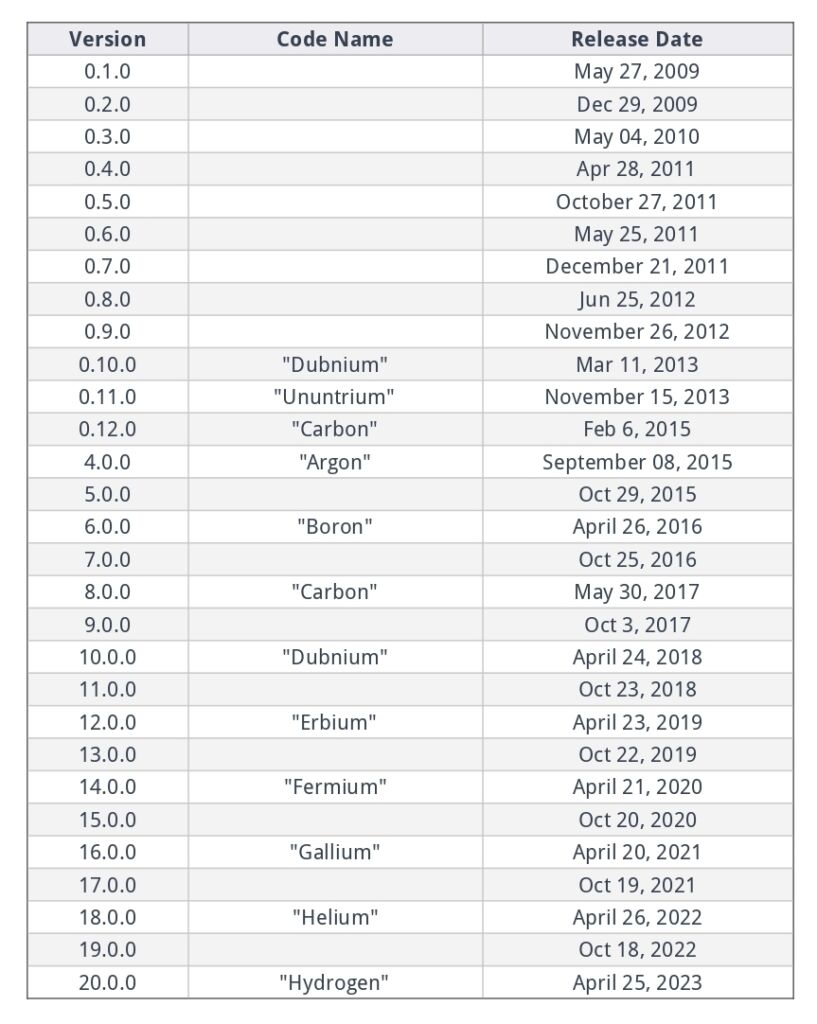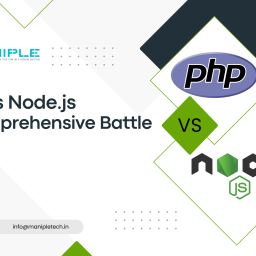Introduction
Node.js, the powerful JavaScript runtime environment, recently celebrated its 14th anniversary. Since its inception in 2009 by Ryan Dahl, Node.js has revolutionized the world of web development, enabling developers to build scalable and high-performance applications. Over the years, Node.js has evolved significantly, becoming a popular choice for developers worldwide. In this blog, we will take a look at the remarkable journey of Node.js, highlighting its major milestones, key features, and the impact it has made on the development community.
The Birth of Node.js
The history of Node.js can be traced back to 2009 when Ryan Dahl, a developer, introduced this groundbreaking technology. At that time, JavaScript was primarily known as a language for building interactive websites on the client-side. However, Dahl envisioned a way to leverage JavaScript on the server-side as well. He wanted to create a platform that could handle concurrent connections and I/O-intensive tasks efficiently.
Dahl’s vision led to the birth of Node.js. He built it on the V8 JavaScript engine, which was developed by Google for their Chrome browser. By utilizing V8’s high-performance runtime environment, Node.js was able to execute JavaScript code outside the browser. This breakthrough opened up new possibilities for developers, as they could now use JavaScript to build full-stack applications.
In 2009, Dahl released the initial version of Node.js, marking the beginning of its journey. The release gained attention and generated curiosity within the developer community. It quickly gained popularity due to its unique architecture and powerful features. One of the key innovations introduced by Node.js was its event-driven, non-blocking I/O model, which allowed for asynchronous processing and efficient resource utilization.

Node.js gained significant traction in the developer community, and in 2010, the first Node.js conference, NodeConf, was held. The conference provided a platform for developers to share their experiences, exchange ideas, and contribute to the growing ecosystem. Around the same time, Node Package Manager (npm) was introduced, which became a central hub for sharing and managing reusable code packages.
Most Popular WebFrame
Check out this 2023 survey by Stack Overflow, in which developers were asked about their favourite technologies they are using. And Node.js topped the list, with 42.65% of developers preferring it over others.

Celebrated 14th Year of Glory
During the exhilarating month of May 2023, the Node.js community joyously commemorated the remarkable achievements of Node.js, marking a splendid 14-year journey. The event was filled with enthusiasm and a deep sense of gratification. Node.js emerged not only as the frontrunner in programming technology but also served as a catalyst for numerous software engineers, empowering them to refine their programming prowess by embracing Node.js as their chosen path.
The Node Package Manager (npm)
Introduced in January 2010, the npm (Node Package Manager) coincided with the initial launch of Node.js. Since then, it has emerged as a vital tool for developers, playing a crucial role in managing JavaScript dependencies and facilitating package management within the Node.js ecosystem. This platform has significantly transformed the way code is shared and reused, bringing convenience and efficiency to the development process.
The npm platform offers its services free of charge, allowing developers to access its vast repository of packages without any financial barriers. Today, npm stands as the largest package registry globally, hosting millions of packages, with the repository containing over 800,000 code packages to date. This extensive collection caters to the diverse needs of developers across various domains and ensures a rich resource pool for software development.
While npm predominantly serves as a hub for open-source software, it also serves the needs of organizations engaging in private development. Through npm, these organizations can effectively manage their proprietary code and collaborate securely within their development teams. The platform supports both public and private package management, offering flexibility for developers working on projects with different levels of accessibility.
An appealing aspect of npm is its accessibility. Users can freely download any public software packages available on the platform without requiring any registration or login credentials. This ease of access further promotes the sharing and distribution of code, fostering a vibrant and collaborative developer community.
In summary, the introduction of npm in 2010 revolutionized code sharing and reuse within the Node.js ecosystem. As the largest package registry worldwide, npm offers a vast collection of packages and serves as a go-to resource for developers across various domains. Whether for open-source or private development, npm provides an efficient and accessible platform for managing JavaScript dependencies and accelerating the software development process.
Why Node.js is so Popular
Node.js has garnered widespread acclaim owing to various factors that have set it apart from comparable systems. Node.js stands out due to its array of distinct advantages that contribute to its popularity. Below are several noteworthy benefits offered by Node.js
- Asynchronous and Non-blocking: One of the standout features of Node.js is its asynchronous, event-driven architecture. It uses a single-threaded event loop that efficiently handles multiple concurrent connections without blocking the execution of other tasks. This approach enables high scalability and responsiveness, making Node.js ideal for handling real-time applications and I/O-intensive tasks.
- JavaScript Everywhere: Node.js uses JavaScript as its programming language both on the server-side and client-side. This allows developers to use the same language and codebase throughout the entire application stack, promoting code reuse and reducing the learning curve. JavaScript’s popularity and vast ecosystem of libraries and tools further contribute to the productivity and efficiency of Node.js development.
- High Performance: Node.js is built on the V8 JavaScript engine, developed by Google. V8 is known for its high-performance execution and optimization capabilities. Node.js leverages this powerful engine to execute JavaScript code with exceptional speed and efficiency, resulting in excellent performance for web applications. Its non-blocking I/O model and lightweight nature also contribute to its performance advantages.
- Scalability and Handling Concurrent Connections: Node.js excels in handling a large number of concurrent connections, making it well-suited for building highly scalable applications. Its event-driven architecture and non-blocking I/O operations enable efficient resource utilization, allowing Node.js applications to handle thousands of concurrent requests with ease. This scalability is particularly useful for applications that require real-time data processing, such as chat platforms or streaming services.
- Extensive Ecosystem: Node.js has a vibrant and expansive ecosystem, supported by a vast collection of open-source libraries, frameworks, and tools. The Node Package Manager (npm) hosts millions of packages, enabling developers to leverage existing solutions and easily integrate third-party modules into their projects. This rich ecosystem promotes developer productivity, speeds up development cycles, and encourages collaboration within the Node.js community.
- Cross-platform Compatibility: Node.js is cross-platform, meaning it can run on various operating systems, including Windows, macOS, and Linux. This flexibility allows developers to build applications that can be deployed across different environments without major modifications. It also simplifies the deployment process and makes it easier to maintain consistency across different platforms.
- Community Support: Node.js benefits from a large and active community of developers who actively contribute to its growth and improvement. The community provides extensive documentation, resources, and support forums where developers can find assistance, share knowledge, and collaborate on projects. The vibrant community ensures that Node.js remains up-to-date, secure, and responsive to the evolving needs of developers.
Here you can see, Node.js stands out with its asynchronous, event-driven architecture, JavaScript ubiquity, high performance, scalability, extensive ecosystem, cross-platform compatibility, and strong community support. These advantages have contributed to Node.js becoming a popular choice for building modern web applications and have propelled its widespread adoption in various industries.
Where Node.js can be used?
Node.js is a handy tool that developers can use to create all sorts of applications and services for different purposes. It’s commonly used for various tasks, such as
- Node.js in Web Application Development: Node.js gained immense popularity for building real-time applications, such as chat applications, collaborative tools, and streaming platforms. Its lightweight and efficient nature made it an ideal choice for handling concurrent connections and delivering data in real time to clients. Furthermore, frameworks like Express.js, Meteor.js, and Socket.IO emerged, providing developers with robust tools for building web applications with Node.js.
- Node.js in Microservices and APIs: Node.js has been widely adopted in the development of microservices and APIs. Its lightweight nature, coupled with its ability to handle a large number of connections, makes it an excellent choice for building scalable and performant backend services. With frameworks like Nest.js and Fastify, developers can easily create microservices architectures, enabling modular and maintainable codebases.
- Node.js for Serverless Computing: The rise of serverless computing brought new opportunities for Node.js. Platforms like AWS Lambda, Azure Functions, and Google Cloud Functions provide seamless integration with Node.js, allowing developers to write functions that can be executed on-demand without provisioning or managing servers. This combination of Node.js and serverless computing enables developers to build highly scalable and cost-effective applications.
- Other: Node.js is so versatile and scalable which is the main reason that it has made it a popular choice for various application domains, and its ecosystem continues to evolve to support new use cases.
- Command-line Tools: Node.js provides a rich set of modules and libraries that facilitate the development of command-line tools. Developers can leverage Node.js to create tools for task automation, build processes, code generation, and more, making development workflows more efficient.
- Real-time Applications: Node.js excels in building real-time applications that require instant data updates and bidirectional communication between the client and server. Examples include chat applications, collaborative document editing tools, live dashboards, and multiplayer games.
- Streaming Applications: Node.js has robust support for streaming data, making it suitable for applications that involve large-scale data processing, media streaming, file uploads, or real-time analytics.
- Internet of Things (IoT): Node.js is increasingly used in IoT applications where it can connect and communicate with IoT devices, collect data, and process it in real-time. Its lightweight footprint and event-driven architecture make it an excellent choice for resource-constrained devices and IoT gateways.
Competitor of Node.js?
While Node.js has gained significant popularity and adoption, there are a few notable competitors in the server-side runtime environment space. Some of the main competitors to Node.js include:
- Deno: Deno is a secure JavaScript and TypeScript runtime built by the creator of Node.js, Ryan Dahl. It addresses some of the perceived shortcomings of Node.js, such as improved security, better module management, and a more modern and developer-friendly approach. Deno provides built-in TypeScript support, a secure sandbox environment, and a different module resolution system compared to Node.js.
- Java: Java is a long-standing and widely-used programming language that offers robust server-side capabilities. It has a large ecosystem, excellent performance, and a mature set of frameworks and libraries for building enterprise-level applications. Java’s strong presence in the enterprise space and its extensive tooling and support make it a notable competitor to Node.js.
- Python: Python is a versatile programming language that is well-suited for server-side development. It is renowned for its simplicity, readability, and ease of use. Python has a broad range of frameworks and libraries, making it a popular choice for web development, data processing, and machine learning applications. With frameworks like Django and Flask, Python provides a strong alternative to Node.js.
- Ruby: Ruby is another programming language that has gained popularity for web development. It is known for its elegant syntax, developer-friendly approach, and a robust framework called Ruby on Rails. Ruby on Rails provides a comprehensive set of tools and conventions for building web applications, offering an alternative to Node.js for those who prefer the Ruby programming language.
- Go: Go (also known as Golang) is a statically-typed programming language developed by Google. It emphasizes simplicity, efficiency, and high-performance concurrency. Go has gained popularity in the web development space due to its fast execution speed, efficient memory usage, and built-in support for concurrent programming. It offers a different approach to concurrency compared to Node.js, making it a potential competitor.
It’s important to note that while these languages and runtimes compete with Node.js in certain aspects, Node.js has established itself as a dominant force in the JavaScript ecosystem, particularly for server-side development. Its event-driven, non-blocking I/O model, extensive package ecosystem, and strong community support continue to make it a preferred choice for many developers.
The latest version of Node.js
Node.js is a powerful tool for developing real-time applications that are both efficient and scalable. The Node.js landscape is constantly evolving with new versions and releases being introduced. As you explore the official Node.js website, you’ll encounter two distinct paths to choose from.
One option is the LTS (Long Term Support) version, which offers a stable and reliable set of features that are recommended for long-term support. On the other hand, the current version includes experimental features that are still being tested and may come with a higher risk of encountering bugs and errors.

Version History of Node.js
Check out the following list of all Major version releases
NOTE: Releases 1.x through 3.x were called “io.js” as they were part of the io.js fork. As of Node.js 4.0.0, the former release lines of io.js converged with Node.js 0.12.x into unified Node.js releases.

Bright Future of Node.js
The future of Node.js looks promising, as it continues to evolve and adapt to meet the changing needs of developers and the industry. Here are some key aspects that indicate a bright future for Node.js:
- Continued Growth and Adoption: Node.js has already witnessed significant growth and widespread adoption, powering numerous high-profile applications and services. Its popularity is likely to continue growing as more developers recognize its benefits, especially in areas such as real-time applications, microservices, and IoT. The increasing demand for scalable and efficient server-side solutions further fuels the growth of Node.js.
- Improved Performance and Efficiency: The Node.js community, along with contributors and maintainers, is continually working to enhance the performance and efficiency of the runtime environment. This includes optimizing the V8 JavaScript engine, refining the event loop, and introducing new features and improvements. As a result, Node.js is expected to become even more performant, enabling faster and more scalable applications.
- Enhanced Security: Security is an ongoing concern in the digital landscape, and Node.js is actively addressing this issue. The community is committed to improving security features, addressing vulnerabilities, and providing best practices to ensure secure development practices. With continuous updates and security enhancements, Node.js aims to strengthen its security posture, making it a reliable choice for building secure applications.
- Ecosystem Expansion: The Node.js ecosystem is thriving, with a vast array of libraries, frameworks, and tools available through the npm package registry. As the ecosystem grows, developers can expect to find more specialized packages, frameworks for specific use cases, and tools that streamline development processes. This expansion further supports developer productivity and accelerates the development of innovative solutions.
- Embracing Modern JavaScript Features: Node.js continues to embrace the latest features and capabilities of JavaScript, ensuring compatibility with the evolving language specifications. This includes support for new syntax, modules, and language features that empower developers to write cleaner, more expressive code. Node.js will likely keep pace with JavaScript advancements, making it easier for developers to leverage the latest language features.
- Integration with Cloud and Container Technologies: Node.js integrates seamlessly with cloud platforms and container technologies, enabling easy deployment and scalability in cloud environments. As the cloud-native ecosystem continues to evolve, Node.js is expected to deepen its integration and compatibility with platforms like Kubernetes and serverless computing frameworks. This ensures that Node.js remains relevant and adaptable to emerging trends in cloud computing.
Overall, the future of Node.js appears bright, driven by its growing adoption, continuous performance improvements, enhanced security measures, expanding ecosystem, support for modern JavaScript features, and compatibility with cloud and container technologies. With its strong community and industry support, Node.js is well-positioned to continue empowering developers to build scalable, efficient, and innovative applications in the years to come.
Conclusion
Node.js has come a long way since its inception, transforming the web development landscape with its innovative features and powerful capabilities. Over the past 14 years, Node.js has enabled developers to build scalable, high-performance applications, and its ecosystem has flourished with a vast array of libraries and tools. As Node.js embarks on its journey beyond 14, we can expect even more exciting advancements and continued growth in the Node.js community.
















Hi i think that i saw you visited my web site thus i came to Return the favore Im attempting to find things to enhance my siteI suppose its ok to use a few of your ideas
Excellent blog here Also your website loads up very fast What web host are you using Can I get your affiliate link to your host I wish my web site loaded up as quickly as yours lol
Simply wish to say your article is as amazing The clearness in your post is just nice and i could assume youre an expert on this subject Well with your permission let me to grab your feed to keep updated with forthcoming post Thanks a million and please carry on the gratifying work
Thank you I have just been searching for information approximately this topic for a while and yours is the best I have found out so far However what in regards to the bottom line Are you certain concerning the supply